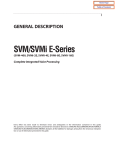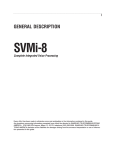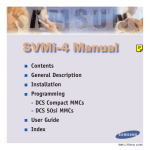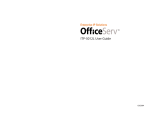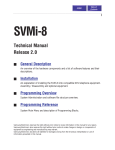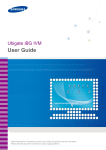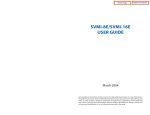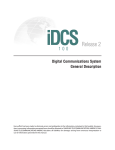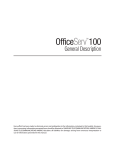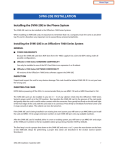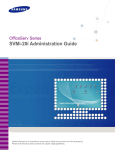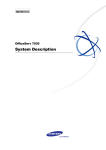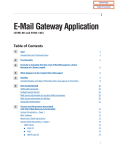Download SVM/SVMi E-Series - General Description
Transcript
Home Page
Table of Contents
GENERAL DESCRIPTION
SVM/SVMi E-Series
(SVM-400, SVMi-2E, SVMi-4E, SVMi-8E, SVMi-16E)
Complete Integrated Voice Processing
Every effort has been made to eliminate errors and ambiguities in the information contained in this guide.
Any questions concerning information presented here should be directed to SAMSUNG TELECOMMUNICATIONS AMERICA.
SAMSUNG TELECOMMUNICATIONS AMERICA disclaims all the liabilities for damages arising from the erroneous interpretation or use of information presented in this guide.
Home Page
Table of Contents
Publication Information
SAMSUNG TELECOMMUNICATIONS AMERICA reserves the right without prior notice to revise information in this publication
for any reason.
SAMSUNG TELECOMMUNICATIONS AMERICA also reserves the right without prior notice to make any changes in design or
components of equipment as engineering and manufacturing may warrant.
Copyright © 2004
Samsung Telecommunications America
All rights reserved. No part of this manual may be reproduced in any form or by any means—graphic, electronic or mechanical, including recording, taping, photocopying or information retrieval systems—without express written permission of the
publisher of this material.
PRINTED IN USA
Home Page
Table of Contents
Table of Contents
1
2
System Overview
The SVM/SVMi E-Series System
1.1
The SVM/SVMi E-Series Capacity and Compatibility Chart
1.3
Auto Attendant
1.4
Voice Mail
1.4
System Capacities
1.4
Hardware Description
SVM-400E
2.1
Main System (Mother Board - PCB)
2.1
Power Supply
2.1
DL1 and DL2 Connectors
2.1
Unmarked Connectors
2.1
The Serial Interface
2.2
Data Storage Device
2.2
Back Up Adapter
2.2
SVMi-2E
2.3
Main Board (Mother Board - PCB)
2.3
The Serial Interface
2.3
Reset Button
2.3
i-Button
2.3
Data Storage Device
2.4
Back Up Adapter
2.4
SVMi-4E
2.5
Main Board (Mother Board - PCB)
2.5
The Serial Interface
2.5
Reset Button
2.5
Daughter Card
2.5
Upgrade Key
2.6
Data Storage Device
2.6
Back Up Adapter
2.6
Home Page
Table of Contents
Table of Contents
SVMi-8E/SVMi-16E
3
SBC (SVMi-8E/SVMi-16E Motherboard)
2.7
The Serial Interface
2.7
The LAN Interface
2.7
Reset Button
2.7
Back Plane Connector
2.8
LED Indications
2.8
HD Access LED
2.8
VM1 Status LED
2.8
VM2 Status LED
2.8
VM3 Status LED
2.8
AP/D and SD Status LEDs
2.8
VPM Connectors
2.8
Data Storage Device
2.9
Hard Drive
2.9
Compact Flash
2.9
Voice Processing Module (VPM)
2.10
Types of VPM
2.11
Software Features
Feature List
3.1
■
System Features
3.1
■
Auto Attendant Features
3.1
■
Access Manager
3.2
■
Voice Mail Features
3.2
■
Administration Features
3.4
■
Audiotex Features
3.4
■
Fax Features
3.5
■
VoiceForm Questionnaire (Q&A) Features
3.5
Feature Descriptions
3.6
■
System Features
3.6
■
Auto Attendant Features
3.7
■
Access Manager
3.9
■
Voice Mail Features
3.11
■
Administration Features
3.17
■
Audiotex Features
3.18
■
Fax Features
3.18
■
VoiceForm Questionnaire (Q&A) Features
3.19
Home Page
Table of Contents
1
System Overview
The SVM/SVMi E-Series System
The SVM/SVMi E-Series Systems are all designed to meet the demands of the sophisticated voice mail user without sacrificing simplicity.
■
The SVM-400E is a self contained Auto Attendant and Voice Mail System designed for the DS 616.
■
The SVMi-2E/4E/8E/16E are all self contained plug in (In-Skin) Auto Attendant and Voice Mail cards.
o
o
o
o
The SVMi-2E is made to work exclusively for the DS 616 KSU2.
The SVMi-4E can be used on the DCS Compact, DCS 50si, and iDCS 100 systems.
The SVMi-8E will run in a DCS, DCS 50si, iDCS 100, and iDCS 500.
The SVMi-16E can be used only on the iDCS 500.
The SVM/SVMi E-Series may act as an Auto Attendant system only, a Voice Mail System only or both. Out of the
box:
■
The SVM-400E is equipped with 2 ports and can handle 2 calls simultaneously. (There is no Port upgrade
available on this unit.)
■
The SVMi-2E is equipped with 2 ports and can handle 2 calls simultaneously. It can be upgraded by adding
a proprietary i-Button to allow up to 4 ports total, handling 4 calls simultaneously.
■
The SVMi-4E is equipped with 4 ports and can handle 4 calls simultaneously. (There is no Port upgrade available on this unit.)
■
SVMi-8E is equipped with 4 Ports built onto the main PCB assembly and can handle 4 calls simultaneously.
The SVMi-8E can be upgraded to 8 Ports by adding a 4 Port VPM, handling up to 8 calls simultaneously.
■
The SVMi-16E is equipped with 8 Ports built onto the main PCB assembly and can handle 8 calls simultaneously. The SVMi-16E can be upgraded to 12 or 16 Ports by adding tone or two 4 Port VPMs to handle up to
either 12 or 16 call simultaneously.
o
o
VPMs are Voice Processing Modules. These are cards that provide 4 additional Ports of Voice Processing
to the SVMi-8E and SVMi-16E.
There are two different VPMs compatible with both the SVMi-8E and SVMi-16E. They are the VPM-E and
the VPMF-E.
●
●
Both offer 4 additional ports of Voice processing.
The VPMF-E also allows for one FAX DSP to allow for Fax-On-Demand and FaxMail functionality.
On the SVMi-2E/4E/8E/16E units, no external line or power connections are necessary as they are In-Skin products. The power and telephone connections are accomplished directly through the phone system on the back-
1.1
Home Page
Table of Contents
System Overview
plane edge connectors. The SVM-400E is an external unit and has it's own power supply that requires a separate
power cord. The SVM-400E ports must also be connected to the last two digital station positions on the DS 616
for connectivity and integration to the SVM-400E. The SVMi-8E will draw four(4) Power Units (SEPU), as a basic 4
port system and six (6) SEPUs with either of the VPMs installed, increasing the maximum capacity to 8 ports. The
SVMi-16E will draw eight (8) SEPUs as a basic 8 port system, ten (10) SEPUs as a 12 ports system with either of the
VPMs installed, and twelve (12) SEPUs when fully loaded with any combination of the 2 VPMs to the maximum of
16 Ports.
Currently the Message Storage capacity, on the SVM-400E, SVMi-2E, and the SVMi-4E are all the same, approximately 2.5 hours. On either the SVMi-8E or the SVMi-16E the message storage capacity is about 140 hours with a
Hard Drive installed and 7 hours with Compact Flash installed on the SVMi-8E or about 15 hours with Compact
Flash installed on the SVMi-16E.
■
Message Storage Capacities may vary from installation to installation. Number of custom Prompts and
Personal greetings recorded can effect the overall Message Storage Capacity. Also Audiotex and Fax applications can decrease the overall Message Storage Capacity.
■
Message Storage Capacities are reflective of the total amount of drive space available after the Operating
System, Voice Drivers, Application Software, and three standard System Languages are installed. Adding
more languages will decrease the Message Storage Capacity by 30 to 40 minutes for each language added.
Conversely, removing one or two of the three standard languages can increase the Message Storage Capacity
by 30 to 40 minutes for each of the languages removed.
■
As time goes on, improvements in technology will allow for changes in storage time.
The modular design of the SVMi-2E, SVMi-8E, and SVMi-16E allows them to be expanded to add voice ports as
needed. Only one SVM/SVMi E-Series card can be installed in a system and use another voice mail system can NOT
be used in combination with the SVM/SVMi E-Series.
1.2
Home Page
Table of Contents
System Overview
The SVM/SVMi E-Series Capacity and Compatibility Chart
Port Upgrade
Type
Ports
SVMi-16E
SVMi-8E
SVMi-4E
SVMi-2E
SVM-400E
VPM-E and/or VPMF-E
VPM-E and/or VPMF-E
N/A
i-Button
N/A
8
12
16
4
8
4
2
4
2
Compact Flash
Size
256 MB
128 MB
64 MB
64 MB
64 MB
Compact Flash
MSG Storage
15 Hrs.†
7 Hrs.†
2.5 Hrs.†
2.5 Hrs.†
2.5 Hrs.†
Hard Drive Size
2G Partition
2G Partition
N/A
N/A
N/A
Hard Drive MSG
Storage
140 Hrs.†
140 Hrs.†
N/A
N/A
N/A
Mailboxes
Virtually Unlimited‡
1000
100
FAX Ports with
optional VPMF-E
N/A
1
2
N/A
1
25
100
25
N/A
N/A
N/A
LAN
Yes
Yes
N/A
N/A
N/A
Soft Modem
Yes
N/A
N/A
N/A
N/A
Serial I/O
Yes
Yes
Yes
Yes
Yes
Fax Application
Software
Yes
Yes
N/A
N/A
N/A
Audiotex
Application
Software
Yes
Yes
N/A
N/A
N/A
0
0
2
Compact
DCS 50si
iDCS 100
DS 616 KSU2
DS 616
(Both KSU and
KSU2)
SEPU
System
Compatibility
8
12
16
iDCS 500
(Both R 1 & R 2)
4
6
DCS
DCS 50si
iDCS 100 (R1 & R2)
iDCS 500 (R1 & R2)
† : Message storage times can vary based on the number of installed languages. The times in this table were calculated with
the three languages (English, Spanish, and French) that are installed standard. Each language installed will consume 30 - 40
Minutes of Message Storage.
‡ :The SVMi-16E software can literally have an Unlimited number of mailboxes created. However a practical physical limitation
based on size of data storage device, number of installed languages, number and length of personal greetings, number and
length of custom Prompts, and size of the over all application may be between approximately 1, 000 to 10,000 mailboxes.
1.3
Home Page
Table of Contents
System Overview
Auto Attendant
The SVM/SVMi E-Series Auto Attendant works by automatically answering calls and playing one or more custom
prompts to the caller along with some dialing instructions. The caller may then press digits on the keypad to
direct themselves to the appropriate person or department.
The SVM/SVMi E-Series Auto Attendant can work in conjunction with your system operator by answering calls
with a pre recorded prompt or prompts, and offering the caller several possible dialing options including dialing
another extension number, transferring to an operator, accessing pre recorded and stored information, or connecting to voice mail.
Voice Mail
Voice Mail provides services if called stations are unavailable. Upon dialing an extension number, callers may be
routed directly to voice mail or transferred to the extension first. The call may be forwarded from the station
according to various conditions (busy, no answer or all the time).
The system will answer calls with a custom greeting in the Subscriber's (mailbox owner's) own voice. The caller
can then leave a message.
The Subscriber (mailbox owner) can access the mailbox from any location with a DTMF phone and retrieve their
messages. Many options are available to handle the message.
System Capacities
Capacities not mentioned in the SVM/SVMi E-Series Capacity and Compatibility Chart are:
DEFAULT
Maximum Subscribers Digits in
Length
Message Retention
Total Messages per Mailbox
Total Message Duration
1.4
RANGE
Any number from 1 - 16
9999 days
0—9999 days
999
0—9999
600 seconds
0—9999 seconds
Home Page
Table of Contents
2
Hardware Description
SVM-400E
The SVM-400 is a PC based Voice Mail System. All PC components were reduced in size and contained into a small
housing. But, unlike traditional PC based Voice Mail / Auto
Attendant Systems, the SVM-400E has no moving parts. This
adds to the robustness and reliability. All the custom speech
prompts and callers messages are stored in digital form on
static memory. This memory can be faster and more reliable
than conventional disk drives.
The component parts of the SVM-400E are as follows:
Main System (Mother Board - PCB)
This is a self contained voice mail system designed to work exclusively with the DS 616. The SVM-400E works with
both the original DS 616 KSU and the new KSU2.
Power Supply
Since this is a self contained voice mail system it contains it's own internal Power Supply that uses a standard PC
AC Power Cord for connectivity to a standard 110V/60Hz AC outlet. The On/Off switch is built onto the Power
Supply. The On/Off switch must be in the ON position for normal system operation. Turning the Power Switch
OFF will immediately disconnect any callers connected to the SVM-400E.
NOTE: Since pushing the Power Switch to the OFF position during operation will disconnect all callers and immediately turn off the SVM-400E, it should only be used as directed. Pressing this switch when the system is performing Disk I/O could result in data loss or file corruption. This switch should not be pressed if the SVM-400E is
actively processing calls.
DLI1 and DLI2 Connectors
These connectors are used to connect the SVM-400E to the DS 616's last two Digital Line Ports. The SVM-400E
works with both the original DS-616 KSU and the new KSU2.
Unmarked Connectors
These connectors are next to the two DLI connectors and are not used at this time.
2.1
Home Page
Table of Contents
Hardware Description
The Serial Interface
This can be used to connect a modem or PC and provide local or remote PC based administration.The connector
is called SIO. The use of this connector is optional and it is not necessary to have anything connected in order for
the SVM-400E to process calls.
Data Storage Device (Memory)
The Data Storage device consists of Compact Flash (CF). The current size of this CF
is 64 MB. This allows for the Operating System, Application Software, and all the
Prompts, Greetings, and Message Storage. The CF for the SVM-400E is available
only from SAMSUNG.
Back Up Adapter (Optional)
The Back Up Adapter allows the removable CF to be installed in the PCMCIA card
slot of a Laptop PC. When this is done a back up may be made of the customer
database. This item is available from www.sandisk.com or Insight Direct.
2.2
Home Page
Table of Contents
Hardware Description
SVMi E-Series
Unlike traditional PC based Voice Mail / Auto Attendant Systems, the SVMi E-Series installs inside the telephone
equipment and operates as an integral part of it. This is referred to as "In-Skin" and makes the SVMi E-Series proprietary to the Samsung family of Phones Systems.
SVMi-2E
The components parts of the SVMi-2E are as follows:
Main Board (Mother Board - PCB)
This is a self contained voice mail system on a plug in card designed to
work exclusively with the DS 616 KSU 2.
The Serial Interface
The connector is called the SIO connector and can be used to connect a
modem or PC to provide local or remote PC based administration. The
use of this connector is optional and it is not necessary to have anything
connected in order for the SVMi-2E to process calls.
Reset Button
The white button located on the component side of the PCB to the left
of the SIO is the reset button. Pressing this will immediately restart the
SVMi-2E system and will disconnect any calls in progress.
NOTE: Since pressing the RESET button during operation will disconnect
all callers and immediately restart the SVMi-2E, it should only be used as
directed. Pressing this button when the system is performing Disk I/O
could result in data loss or file corruption. This button should not be pressed if the SVMi-2E is actively processing
calls.
i-Button (Optional)
The i-Button (a.k.a. upgrade key) is a small hardware device installed in the
SVMi-2E i-Button Socket. It provides the license for two additional ports
increasing the number of available ports from 2 to 4, and the number of
mailboxes from 25 to 100.
The 2 port i-Button for the SVMi-2E card is available only from SAMSUNG.
NOTE: The SVMi-2E i-Button is proprietary to the SVMi-2E ONLY. It can NOT
be used on any other SVM/SVMi E or non-E Series Products.
2.3
Home Page
Table of Contents
Hardware Description
Data Storage Device (Memory)
The Data Storage device consists of Compact Flash (CF). The current size of this CF
is 64 MB. This allows for the Operating System, Application Software, and all the
Prompts, Greetings, and Message Storage. The CF for the SVMi-4E is available only
from SAMSUNG.
Back Up Adapter (Optional)
The Back Up Adapter allows the removable memory card to be installed in the
PCMCIA card slot of a Laptop PC. When this is done a back up may be made of the
customer database. This item is available from www.sandisk.com or Insight Direct.
2.4
Home Page
Table of Contents
Hardware Description
SVMi-4E
The components parts of the SVMi-4E are as follows:
Main Board (Mother Board - PCB)
This is a self contained voice mail system on a plug in card designed to
work exclusively with the DCS Compact, DCS 50si, and iDCS 100 (both R1
& R2).
The Serial Interface
On the front of the card there is a single connector. The connector is
called the SIO connector and can be used to connect a modem or PC to
provide local or remote PC based administration. The use of this connector is optional and it is not necessary to have anything connected in
order for the SVMi-4E to process calls.
Reset Button
The Black button located on the component side of the PCB half way
between the CF and the bottom of the PCB is the reset button. Pressing
this will immediately restart the SVMi-4E system and will disconnect any
calls in progress.
NOTE: Since pressing the RESET button during operation will disconnect
all callers and immediately restart the SVMi-4E, it should only be used as
directed. Pressing this button when the system is performing Disk I/O
could result in data loss or file corruption. This button should not be
pressed if the SVMi-4E is actively processing calls.
Daughter Card (Standard)
The Daughter Card is a small hardware device that piggy backs onto the main SVMi4E PCB. The Daughter Card comes in two configurations. Either will provide the
same functionality as the other.
The standard configuration contains circuitry (leaving the upgrade Key socket
unpopulated) to provide the additional two port license that increases the number
of available ports from 2 to 4, and the number of mailboxes from 25 to 100.
An optional configuration of the Daughter card does not have the circuitry and
instead the Upgrade Key socket would be populated with an Upgrade Key (description below).
With either configuration the SVMi-4E can not be expanded beyond 4 ports and 100
mailboxes. This Daughter Card is necessary to use the SVMi-4E in the DCS 50si and
iDCS 100.
NOTES:
1.
The Daughter Card is automatically installed by the factory on every SVMi-4E PCB and is not required to be
ordered separately.
2.5
Home Page
Table of Contents
Hardware Description
2.
The Daughter Card configuration is solely determined by the factory.
3.
The Daughter Card circuitry and Upgrade Key can not be used simultaneously.
Upgrade Key (Optional)
The upgrade key is a small hardware device installed in the SVMi-4E daughter board card. It provides the license for two additional ports increasing the
number of available ports from 2 to 4, and the number of mailboxes from 25
to 100.
The 2 port upgrade key for the SVMi-4E card is available only from SAMSUNG.
NOTE: The SVMi-4E Upgrade Key is proprietary to the SVMi-4 and SVMi-4E.
It can NOT be used on any other SVM/SVMi E or non-E Series Products.
Data Storage Device (Memory)
The Data Storage device consists of Compact Flash (CF). The current size of this CF
is 64 MB. This allows for the Operating System, Application Software, and all the
Prompts, Greetings, and Message Storage. The CF for the SVMi-4E is available only
from SAMSUNG.
Back Up Adapter (Optional)
The Back Up Adapter allows the removable memory card to be installed in the
PCMCIA card slot of a Laptop PC. When this is done a back up may be made of the
customer database. This item is available from www.sandisk.com or Insight Direct.
2.6
Home Page
Table of Contents
Hardware Description
SVMi-8E/SVMi-16E
The components parts of the SVMi-8E/SVMi-16E are as follows:
SBC (SVMi-8E/SVMi-16E
Motherboard)
SBC (Single Board Computer) is the main circuit card that connects to the backplane of
the phone systems.The disk drive and voice
processing modules connect to this card.
■
The SVMi-8E connects to the DCS, DCS
50si, iDCS 100 (R1 & R2), and iDCS 500
(R1 & R2)
■
The SVMi-16E connects to the iDCS 500
(R1 & R2)
On the front of the card there are two connectors. The use of these connectors is
optional and it is not necessary to have anything connected in order for the SVMi8E/SVMi-16E to run.
The Serial Interface
This can be used to connect a modem or PC
to provide local or remote PC based administration. The connector is called the SIO
connector.
SVMi-8E
SVMi-16E
The LAN Interface
This is used for data transfer or database back up. The connector is called the LAN connector. The main purpose
for this connector is for system file transfer (Back-up and Restore). The SVMi-8E and SVMi-16E are designed to
back up and restore data to the customer provided LAN, or directly to a PC or Laptop connected to this LAN connector.
Reset Button
The red button marked RST is the reset button. Pressing this will immediately restart the SVMi-8E/SVMi-16E system and will disconnect any calls in progress.
Since pressing the RESET button during operation will disconnect all callers and immediately restart the SVMi8E/SVMi-16E, it should only be used as directed. Pressing this button when the system is performing Disk I/O
could result in data loss or file corruption. This button should not be pressed if the SVMi-8E/SVMi-16E is actively
processing calls.
2.7
Home Page
Table of Contents
Hardware Description
Back Plane Connector
This is the connector to the phone system.
LED Indications
There are Eight (8) LEDs on the SVMi-8E/SVMi-16E motherboard, the one marked HD will flash whenever the hard
disk drive is being accessed, others will give indications of various board functionality.
HD Access LED
The HD access LED will flash whenever the Hard Drive or CF
is being accessed.This works in a similar way to the Hard Disk
access LED on your desk top PC.
VM1 Status LED (SVMi-8E Only)
This indicates that one or more of the 1st four ports (port 1
thru 4) are off hook. If you were to reset or turn the power off
you would disconnect the caller connected to the active
port(s).
VM2 Status LED (SVMi-8E Only)
This indicates that one or more of the Last four ports (port 5
thru 8) are off hook. If you were to reset or turn the power off
you would disconnect the caller connected to the active
port(s).
VM3 Status LED (SVMi-8E Only)
This LED is currently not in use.
SVMi-16E
SVMi-8E
AP/D and SD Status LEDs (SVMi-16E Only)
The Status LEDs show the operating status of the card. A status of green indicates SVMi-16E is down and it is safe
to power off the switch. A status of red indicated the SVMi-16E is up and running and it is NOT safe to power down
the switch without possible corruption to the SVM databases.
VPM Connectors
This is a proprietary connector for installing 1 voice processing module (VPM) on the SVMi-8E and up to 2 VPMs
on the SVMi-16E. Any of the VPM connectors can be used for either of the two types of VPMs. The VPMs are, a
VPM-E that provides an additional 4 voice ports and a VPMF-E that also provides an additional 4 ports but enables
one port to be used for Fax applications.
2.8
Home Page
Table of Contents
Hardware Description
Data Storage Device (Memory)
The SVMi-8E/SVMi-16E is available with two different types of data storage devices, Hard Drive and Compact Flash
units. Only one or the other can be used on a single system. Both device types are used for storing the main system program as well as all messages, and prompts. The amount of storage time is determined by the size of the
drive measured in Mega Bytes (MB).
Hard Drive
Compact Flash and Adaptor
Hard Drive
The current Hard Drive provides approximately 140 hours of message storage. The hard drive for the SVMi8E/SVMi-16E card is available only from SAMSUNG.
The Hard Disk Drive can be removed or replaced in the event of a problem or upgrade. It is held in place on the
SBC by 4 screws.
The Hard Disk Drive is connected to the SBC with a ribbon cable. Note that the connector on the Hard Drive has
4 extra pins on the end of the connector. Do not use these pins.
Compact Flash
The Compact Flash is used in the same way as the Hard Drive and is also only available from SAMSUNG. The current Compact Flash on the SVMi-8E provides approximately 7 hours of message storage. On the SVMi-16E the
Compact Flash provides approximately 15 hours of message storage. One of the benefits of using the Compact
Flash is that it can be removed from the System for archiving data purposes.
Systems must be properly shut down and off before removing the Compact Flash card from the SVMi-8E/SVMi16E.
2.9
Home Page
Table of Contents
Hardware Description
Voice Processing Module (VPM)
The 4 port Voice Processing Module is a small removable hardware board called a VPM. It connects to the SVMi8E/SVMi-16E motherboard. When it is installed in the SVMi-8E/SVMi-16E card it increases the number of available
ports by 4.
IMPORTANT NOTE: The VPMs used in this product appear very similar to the VPMs in our previous CADENCE and
SVMi-8 products, but they are not interchangeable. If the VPMs are not labeled with the letters SEC and/or do not
say VPM02 they will not work in the SVMi-8E/SVMi-16E products.
The VPM is used to:
■
Move the digital speech and fax information between the SVMi-8E/SVMi-16E system and the phone system.
■
Generate and detect DTMF
■
Record and play back speech
Each VPM has 4 channels. This means that for each VPM installed, up to four additional simultaneous callers can
be connected to the SVMi-8E/SVMi-16E.
The VPM is attached to the SBC by an edge connector.
The SVMi-8E card can accommodate 1 of these cards allowing up to 8 simultaneous callers. The SVMi-16E card
can accommodate up to 2 of these cards allowing up to 16 simultaneous callers. The SVMi-8E card can not be
expanded beyond 8 ports, and the SVMi-16E can not be expanded beyond 16 ports.
2.10
Home Page
Table of Contents
Hardware Description
Types of VPM
There are two types of VPM. The VPM-E and the VPMF-E.
VPM-E-4 Voice Processing Module BoardBack View
■
VPM-E-4 Voice Processing Module Board
with 1 Port Fax Support-Back View
VPM-E-4 Port Voice Processing Module
This add-on-card provides 4 channels of voice otherwise known as ports. It allows 4 simultaneous callers to
use the services of the SVMi-8E/SVMi-16E. One of these cards may be added to the SVMi-8E, and up to Two
of these card can be added to the SVMi-16E.
■
VPMF-E-4 Port Voice Processing Module with 1 Port Fax Support
This add-on-card provides 4 channels of voice otherwise known as ports. It allows 4 simultaneous callers to
use the services of the SVMi-8E/SVMi-16E. Any one of these ports can use the fax services of the SVMi8E/SVMi-16E card. One of these cards may be added to the SVMi-8E, and up to two of these cards can be
added to the SVMi-16E. On the SVMi-16E you can use any combination of VPMs.
2.11
Home Page
Table of Contents
3
Software Features
The software for the SVM/SVMi E-Series is installed at the factory. All that is needed is for it to be customized to
meet the individual requirements of each installation. In some cases even this may not be necessary.
The SVM/SVMi E-Series software comes equipped with many useful features to fit a wide range of call processing
requirements.
SYSTEM FEATURES
Q
Q
Q
Q
Q
Q
Q
Q
Q
Q
Q
Q
Q
Q
Caller ID Compatible
Expandable (The SVM-400E and SVMi-4E are NOT Expandable)
Fax Detection and Transfer
Flexible Numbering Plan
Individually Defined Mailboxes and Extensions
Keyset Display and Soft Key Support
MOH Supply
Multiple Mailbox Support
Operating Mode-Oriented Call Processing
Operating Mode Override
Proprietary Design
Recordable System Prompts
Schedule Table
Synchronized Clock
AUTO ATTENDANT FEATURES
Q
Q
Q
Q
Q
Q
Q
Q
Q
Alphabetic Directory (Multiple)
Auto Attendant Routing
Automatic After Hours Answering
Announce Hold Position
Announce Hold Time
Camp On Support
Direct to Mailbox
Holidays and Special Events Scheduler
Incoming Call Overflow
3.1
Home Page
Table of Contents
Software Features
Q
Q
Q
Q
Q
Q
Interruptible Voice Prompts
Maximum Greeting Length
Multiple Call Handling
Multiple Language Support
Operator Access
Single Digit Call Routing
ACCESS MANAGER
Q
Q
Q
Q
Q
Q
Q
Q
Q
Q
Q
Q
Q
Q
Q
Q
Q
Blocked Personal Greeting
Busy Personal Greeting
Call Blocking
Call Forwarding
Day Primary or No-Answer Personal Greeting
Find Me
Follow Me (Off Premises Transfer)
Hold for Busy Station
Multiple Personal Greetings (9)
Night Intercept
Night Personal Greeting
Park and Overhead Page
Personal Customized Options
Retrieve Public Caller from Hold
Screened Rejected Personal Greeting
Stored Telephone Numbers
Weekly Availability Schedule
VOICE MAIL FEATURES
Q
Q
Q
Q
Q
Q
Q
Q
Q
Q
Q
Q
Q
3.2
Answer Machine Emulation
Auto Conversation Record
Auto Forward
Auto Log In
Auto Message Play
Broadcast
Call Back
Call Forward to Voice Mail
Call Record
Call Back Request Messages
Date and Time Stamp
Delivery Imperative
Direct Messaging / Quick Memo
Home Page
Table of Contents
Software Features
Q
Q
Q
Q
Q
Q
Q
Q
Q
Q
Q
Q
Q
Q
Q
Q
Q
Q
Q
Q
Q
Q
Q
Q
Q
Q
Q
Q
Q
Q
Q
Q
Q
Q
Q
Q
Q
Q
Q
Q
Q
Distribution Lists
Extended Prompting
External Number Notification
External Pager Notification
FaxMail (requires VPM-E installed) (only available on the SVMi-8E and SVMi-16E)
Future Delivery
Group and Sort Messages Prior to Play
Individual Mailbox Greeting
Individual Mailbox Name
Individual Mailbox Password
Maximum Number of Messages
Message Address Verification
Message Alert Notification Schedule
Message Counter
Message Delete
Message Delivery Options
Message Fast Forward
Message Forward With Append
Message Length Controls
Message Pause
Message Play Order
Message Replay
Message Reply
Message Retention Time by Subscriber
Message Retrieve
Message Rewind
Message Save
Message Send
Message Scan
Message Skip
Message Undelete
Message Waiting Light Indication
Multiple Subscriber Mailbox Login
Multiple Subscriber Mailboxes
Name Addressing
Net Mailbox (AMIS)
New / Old Selection
One Touch Access
Pager Notification Schedule
Personal Mailbox Administration
Private (Confidential) Messages
3.3
Home Page
Table of Contents
Software Features
Q
Q
Q
Q
Q
Q
Q
Q
Q
Q
Q
Q
Quick Memo
Reminder
Reply Required
Retrieve Public Caller from Mailbox
Return Receipt (Certified Messages)
Self Memo / Reminder
Self Memo / Reminder Categories
Speed Control
Subscriber Workload Manager
Until… Scheduling
Urgent Messages
Volume Control
ADMINISTRATION FEATURES
Q
Q
Q
Q
Q
Q
Q
Q
Q
Q
Q
Q
Q
Activity Display
Administrators Mailbox
Auto Delete Subscribers
Automatic Setup
Back Up and Restore
Default Operation
Password Security
Programming - On Site Or Remote (Some units require an external modem for Remote Programming)
Subscriber Administration
Subscriber Database
System Reports
Voice Prompted Programming
Voice Studio
AUDIOTEX FEATURES (only available on the SVMi-8E and SVMi-16E)
Q
Q
Q
Q
Audiotex
Audiotex Librarian
Automatic Announcement Delete
Announcement Replay
FAX-ON-DEMAND FEATURES (only available on the SVMi-8E and SVMi-16E)
Q
Q
Q
Q
Q
3.4
Caller Selected Delivery
Compound or Multiple Documents
Document Librarian
Guaranteed Fax
Voice Labels
Home Page
Table of Contents
Software Features
VOICE FORM QUESTIONNAIRE (Q & A) FEATURES
Q
Multiple Response Destinations
Playback Header Prompt
Team Transcription
Unlimited Questions
Q
VoiceForm
Q
Q
Q
3.5
Home Page
Table of Contents
Software Features
Feature Descriptions
SYSTEM FEATURES
Caller ID Compatible Caller ID Compatible If you subscribe to Central Office based Caller ID, the SVM/SVMi ESeries is compatible. The Caller ID data appearing on keysets is also saved in your voice mail box for each message you receive. This can be used for call back or simply to identify the caller.
Expandable
■
The SVMi-2E can be easily field upgradable from 2 to 4 ports by simply adding the i-Button upgrade key.
■
The SVMi-8E can be easily field upgraded from 4 ports, to 8 ports by simply adding an additional 4 port Voice
Processing Module. This upgrade doubles the call handling capabilities of the system.
■
The SVMi-16E can be easily field upgraded from 8 ports, to 12 or 16 ports by simply adding one or two additional 4 port Voice Processing Module.
■
The SVM-400E and the SVMi-4E are not expandable.
Fax Detection and Transfer The SVM/SVMi E-Series can detect a fax call and transfer it to any extension in the
system. This detection can be enabled at any 'menu' and assigned different destinations. For instance, in a menu
offering choices for sales a fax tone would be sent to the sales fax machine, but in a menu offering choices for the
finance department a fax tone would be sent to the finance fax machine (NOTE: This feature does NOT require a
VPMF-E to be installed).
Flexible Numbering Plan An organization can assign an extension, a mailbox, or an announcement to any identification number from one to ten digits. All of these resources can share the same identification numbering plan
without conflict. For example, an organization can have, in one SVM/SVMi E-Series system, an extension numbered 123, a mailbox numbered 123 and an announcement numbered 123. In addition, the SVM/SVMi E-Series
can distinguish between variable length identification numbers beginning with the same digit, such as extension
number 1, or 12, or 1234567890.
Individually Defined Mailboxes and Extensions Extensions and Mailboxes are separate and independent system resources. A mailbox does not have to be defined in terms of an extension, or an extension in terms of a mailbox, in order for the SVM/SVMi E-Series to associate them.
An Extension is used for routing callers to the Subscriber. This gives the Subscriber complete control (if authorized) over how, where and when they take their calls.
A Mailbox is simply used for taking and controlling messages for the subscriber in the event he/she can not (or
do not wish to) speak to their callers.
Keyset Display and Soft Key Support If you have a display keyset the number of new messages will be displayed on it. The display will also echo many of the options available. You will be able to negotiate through the
SVM/SVMi E-Series menus using the keyset display and the soft keys below the display to respond to the prompts.
MOH Supply Music or announcements may be recorded in the SVM/SVMi E-Series memory and used by the
phone system for Music On Hold. The recorded announcement or music will play in a continuous loop and may
be used to provide custom on hold announcements or promotional messages.
Multiple Mailbox Support The SVM/SVMi E-Series can, in principle, support up to 1000 mailboxes, although
obviously having only the 4 or 8 port hardware places practical limits on the system according to the individual
system traffic, and type of application.
3.6
Home Page
Table of Contents
Software Features
Operating Mode-Oriented Call Processing The SVM/SVMi E-Series can be configured to automatically change
between up to 99 different customer operating modes, based upon the time of day, day of week, or specific calendar date. During an operating mode, every aspect of the call automation application, including port utilization;
caller scripts; routing solutions; and call coverage options can be customized to meet the organization's operating requirements. SVM/SVMi E-Series’ Schedule Table automatically changes to the correct mode without human
involvement.
Operating Mode Override Under exceptional circumstances, such as adverse weather conditions or other organizational emergencies when the office may be inaccessible, the administrator can override the Schedule Table.
The administrator calls the SVM/SVMi E-Series, enters the administrative password, and selects a new operating
mode for any or all ports. The new operating mode can be programmed for the circumstances, or the administrator can simply record a new company greeting which explains the circumstances to callers.
Proprietary Design
■
The SVM-400E is designed to work specifically with the DS 616. On both the KSU and KSU 2 models.
■
The SVMi-2E is designed to work exclusively on the DS 616 KSU 2.
■
The SVMi-4E is designed to work specifically with the DCS Compact, DCS 50si and the iDCS 100 (R1 & R2).
■
The SVMi-8E is designed to work specifically with the DCS 50si, DCS, and iDCS 100.
■
Both the SVMi-8E and SVMi-16E are designed to work with the iDCS 500 (R1 & R2).
This proprietary design allows tighter integration with the phone system and allows for enhanced features like
Call Record, Answer Machine Emulation and Display and Soft Key support not normally available with third party
Voice Mail / Auto Attendant systems.
Recordable System Prompts Although the SVM/SVMi E-Series contains all the spoken prompts to provide an
operational system, some people may want to add or record some additional prompts. This can easily be done
using the built in voice studio. Any prompt in the system can be re recorded.
Schedule Table The schedule table automatically controls system mode by individual ports, time of day, day of
week and calendar date without human intervention. It is capable of scheduling ninety-nine mode changes per
day for 366 consecutive days. The administrator can manually override the schedule table at any time from a
touchtone telephone, the system console, or from an administration terminal. For Holidays and Calendar of
Events, the Schedule Table can be used to schedule holiday and special event caller prompts to better inform and
serve callers.
Synchronized Clock The SVM/SVMi E-Series clock is responsible for providing each message with a date and
time stamp. This clock is always synchronized with the phone system, as is changing between day and night
modes.
AUTO ATTENDANT FEATURES
Alphabetic Directory (Multiple) Callers who do not know an extension number in the system but do know a
name, may enter the first few letters of the person's name and be transferred.This system may even be used internally if an extension number is not known.The SVM/SVMi E-Series allows for over 1000 unique directory systems,
each one can search on either the first or last name.
Auto Attendant Routing The Auto Attendant can transfer or route callers based on the digits they enter. Callers
may be transferred to station, groups or the system directory to select a subscriber based on their name.
Additionally, the Auto Attendant will integrate directly with 'Question and Answer', 'Audiotex', and 'Fax-onDemand' applications.
3.7
Home Page
Table of Contents
Software Features
Automatic After Hours Answering The Main Auto Attendant greeting for the SVM/SVMi E-Series changes from
the day to the night greeting automatically when the phone system changes from day to night mode. Multiple
additional modes may be defined for special applications.
Announce Hold Position If callers are allowed to hold for a busy extension, the SVM/SVMi E-Series is able to intermittently inform the caller of their place in the queue.
Announce Hold Time If callers are allowed to hold for a busy extension, the SVM/SVMi E-Series is able to intermittently inform the caller of the estimated hold time before being answered.
Camp On Support Each station user on the system may decide if they want the SVM/SVMi E-Series to transfer
additional calls to them if they are on the phone. Calls transferred to a busy station, if unanswered will be sent to
voice mail or any other destination according to the user's needs.
Direct to Mailbox You may have mailboxes on the SVM/SVMi E-Series system that do not have associated stations. This is ideal if you have a small number of employees in your office but numerous employees outside the
office that need to keep in contact.
Holidays and Special Events When your business closes because of a holiday or special event the SVM/SVMi ESeries can provide a special appropriate prompting to your callers. You may create specific holiday schedules so
that this process becomes automatic.
Incoming Call Overflow The SVM/SVMi E-Series may be programmed to answer any or all lines immediately or
answer only the calls that your operator does not pick up. Overflowed calls may be routed to either a mailbox or
the main company prompt.
Interruptible Voice Prompts At any time during an announcement or greeting, callers may dial a selection and
the SVM/SVMi E-Series will immediately respond. It is not necessary to listen to all the options if you are a 'power
user' and know what you are doing.
Maximum Greeting Length The maximum greeting length can be configured for each subscriber. For example,
greeting length for sales personnel may be up to three minutes, purchasing staff up to five minutes and production staff two minutes.
Multiple Call Handling
■
The SVM-400E can answer and process up to 2 calls simultaneously.
■
The SVMi-2E can answer and process up to 2 calls simultaneously from the factory and 4 calls simultaneously by adding the i-Button Upgrade Key.
■
The SVMi-4E can answer and process up to 4 calls simultaneously.
■
The SVMi-8E can answer and process up to 8 calls simultaneously, with an additional VPM installed.
■
The SVMi-16E can answer and process up to 16 calls simultaneously, with two additional VPMs installed.
Multiple Language Support The SVM/SVMi E-Series supports multiple languages. Up to nine (9) simultaneous
languages can be supported. The default language is English (United States). Spanish (Castilian) and French
(Canadian) are also installed by the factory as standard languages. A list of available languages can be obtained
and installed by your local authorized Samsung Service provider.
Note: Each language installed will take up approximately 5 Megs (30 to 40 minutes) of message storage.
Operator Access Callers may connect with an available operator any time by dialing 0. This is provided that the
customer has someone answering the Operator's calls.
3.8
Home Page
Table of Contents
Software Features
Single Digit Call Routing A menu processor can be configured to recognize single digit routing options, or use
the same digit as the leading entry of a multi-digit routing option. For example, in the menu processor, "1" can be
used to route a caller to the sales department and "103" to transfer the caller to a subscriber's extension.
ACCESS MANAGER
The Access Manager empowers the Subscriber with control over how, what, when, and where they wish to speak
to their callers. The Subscriber may prevent calls from ringing at their extension, or have the calls transferred to
any other extension in the phone system, transferred off-site to any other phone number, or screen the call before
answering them. Any of these conditions can be set to be active until a specified time.The SVM/SVMi E-Series can
even be set with a high priority 'Find Me' instruction that will try to reach the subscriber at multiple locations.
Blocked Personal Greeting This greeting is played to the caller anytime the subscriber enables the Call Blocking
feature in the SVM or sets their keyset to Call Forward All/DND.
Busy Personal Greeting This greeting is played to the caller anytime the subscriber is on the phone and they
have their keyset set to Call Forward Busy or Call Forward Busy/No-Answer.
Call Blocking While a subscriber has call blocking set active, the SVM/SVMi E-Series does not attempt to transfer
a caller to the subscriber's extension. Instead, it immediately plays the subscriber's Call Blocking Greeting - if
recorded. If the Call Blocking Greeting is not recorded, SVM/SVMi E-Series plays the subscriber's Primary NoAnswer Greeting - if recorded.
When that greeting is not recorded, SVM/SVMi E-Series advises the caller that the called party is not available and
offers to the caller additional options. A subscriber sets Call Blocking active through Access Manager Services.
After activating Call Blocking, the subscriber is prompted to indicate how long blocking is to remain active. This
feature can be activated for a number of hours, 1 to 9, for the end of the current business day, for the beginning
of the next business day, for a day of the coming week, for Monday through Sunday, for a specific date, for hour
and minute, or until further notice.
Call Forwarding Forward All Calls allows a subscriber to have their incoming calls answered by an associate at
another internal extension - it is not used to forward calls to an external telephone number. To have calls connected an external number, the subscriber use the Designated Location Service.
When calls are forwarded to another associate's extension, a caller entering the forwarder's extension number will
immediately hear…"Transferring to 'Called Party's Name'. Calls are being forwarded to 'Associate's Name'". If the
associate answers the call, the associate will be prompted as to who the call is forwarded from.
This feature can be activated for a number of hours, 1 to 9, for the end of the current business day, for the beginning of the next business day, for a day of the coming week, for Monday through Sunday, for a specific date, for
hour and minute, or until further notice.
Day / Night Personal Greeting The Night Personal Greeting works in conjunction with the subscriber's Weekly
Availability Schedule.
During the defined availability period the SVM/SVMi E-Series will automatically play the Primary No-Answer
Greeting to callers, unless the subscriber is busy on another call and has recorded a Busy Greeting or Call Blocking
is set active, and a Call Blocking Greeting is recorded.
During the time periods a subscriber is not scheduled available to take calls, and does not have Call Blocking activated, SVM/SVMi E-Series plays the subscriber's Night Greeting If recorded.
Find Me When Find Me is set active, the SVM/SVMi E-Series attempts to deliver calls to the subscriber's designated location, provided neither Call Blocking, nor Forward All Call, is active.The SVM/SVMi E-Series first tries to locate
3.9
Home Page
Table of Contents
Software Features
the subscriber at the subscriber's designated location. Then, if necessary, it tries each of the subscriber's Stored
Telephone Numbers until all numbers have been called.
After each stored telephone number, the SVM/SVMi E-Series will prompt the caller that it is continuing to locate
the subscriber. If SVM/SVMi E-Series cannot locate the subscriber, the subscriber's Call Blocking Greeting is played
to the caller.
This feature can be activated for a number of hours, 1 to 9, for the end of the current business day, for the beginning of the next business day, for a day of the coming week, for Monday through Sunday, for a specific date, for
hour and minute, or until further notice.
Calls transferred to a designated location are automatically a confirmed transfer. The subscriber must press a digit
to accept the transfer or they can press other digits to, 'Reject', 'Redirect', or record a real time greeting that plays
immediately to that caller.
Follow Me (Off Premises Transfer) Each subscriber may have their calls automatically forwarded to a designated location. We call that location, the subscriber's Designated Location. A Designated Location can be an internal
extension or an external telephone number. It can be entered digit-by-digit or the subscriber can enter a Stored
Telephone Number Index Digit representing the location of the appropriate number.
Whenever a subscriber sets his designated location to a number other than his extension number, SVM/SVMi ESeries prompts, "How long do you want this number to be your designated location?" This feature can be activated for a number of hours, 1 to 9, for the end of the current business day, for the beginning of the next business
day, for a day of the coming week, for Monday through Sunday, for a specific date, hour and minute, or until further notice.
Calls transferred to a designated location are automatically a confirmed transfer. The subscriber must press a digit
to accept the transfer or they can press other digits to, 'Reject', 'Redirect', or record a real time greeting that plays
immediately to that caller.
Hold for Busy Station The SVM/SVMi E-Series may be enabled to allow callers to hold for a busy station. When a
caller elects to hold, the SVM/SVMi E-Series places the caller in a Hold Queue. If additional callers attempt to reach
the busy extension and they choose to hold, they can be informed of their position in the queue and the estimated hold time before being connected. Callers given the option to hold may be limited to insure that system
ports are not monopolized. When the limit is reached, callers can be routed to other extensions or applications
that have been configured to deal with this condition.
Multiple Personal Greetings (9) When a subscriber does not answer and accept a call, the SVM/SVMi E-Series
will answer. SVM/SVMi E-Series recognizes five different reasons why a subscriber does not answer a call. We refer
to these reasons as 'Call Coverage Conditions'. SVM/SVMi E-Series allows a subscriber to assign a different personal greeting to each Call Coverage Condition. A condition should be considered a "socket" into which a personal greeting is plugged. The greeting that gets plugged into each "socket" should offer caller options appropriate for that condition.
SVM/SVMi E-Series provides each subscriber nine (9) personal greetings, labeled 1 through 9. A subscriber can
assign (plug in) any greeting to any Call Coverage Condition. However, when a subscriber first logs on to the
SVM/SVMi E-Series, personal greetings numbered 1, 2, 3, 4, and 5, are assigned to their respective Call Coverage
Conditions (No Answer, Busy, Fwd All/DND, Night and Call Screening). The remaining four personal greetings,
labeled 6 through 9 are normally used as alternatives to the greetings assigned to these conditions.
Night Intercept This feature is used in conjunction with the subscriber's availability schedule.When enabled and
the Subscriber is scheduled as unavailable, callers are NOT transferred to the subscriber's extension. Instead, the
SVM/SVMi E-Series immediately plays the subscriber's Night Greeting if recorded.
3.10
Home Page
Table of Contents
Software Features
Night Personal Greeting This greeting plays to the caller anytime the subscriber is scheduled as unavailable
based on the availability schedule. If the subscriber is scheduled unavailable the caller will here the Night
Greeting during a No-Answer Call condition or if Night Intercept is enabled.
Park and Overhead Page For those users who are frequently away from their desk, the SVM/SVMi E-Series provides a Park and Page capability.When a subscriber does not answer a call, the subscriber's personal greeting can
contain an option to be paged. When the caller elects to have the subscriber paged, the SVM/SVMi E-Series parks
the call and plays a prompt through the overhead paging facility that contains the subscriber's name and a pickup code.The SVM/SVMi E-Series waits a programmable period of time for the subscriber to pick-up the call.When
the call is not picked up, the SVM/SVMi E-Series notifies the caller that the page was not answered and plays the
subscriber's Primary or No-Answer greeting.
Personal Customized Options Each subscriber may have different personal options played to the caller. For
example, the caller may wait while the subscriber is paged or the caller may hold until the subscriber is available
to take the call. These options must be enabled by the system administrator.
Retrieve Public Caller From Hold When a subscriber logs on they are notified if a caller is holding, and the
SVM/SVMi E-Series offers to transfer the caller to the subscriber's designated location. If the caller is identified
SVM/SVMi E-Series will speak the caller's name. When the subscriber elects to speak with the caller, he simply
presses 1 and hangs up. If the subscriber elects not to speak with the caller, SVM/SVMi E-Series immediately plays
the subscriber's mailbox greeting.
Screened Rejected Personal Greeting This greeting plays to the caller anytime a subscriber rejects a screened
transferred call from the SVM/SVMi E-Series. The system administrator can authorize the Call Screening feature
per subscriber. Call Screening must be authorized to have a Call Screening Greeting.
Stored Telephone Numbers A subscriber can store up to five telephone numbers where they can usually be
reached, this simplifies the follow me feature as it allows the subscriber to quickly activate commonly used settings.
Weekly Availability Schedule The Weekly Availability Schedule tells SVM/SVMi E-Series the days of the week,
and the hours of the day, that a subscriber is normally available to take calls.When the subscriber does not answer
a call during those time periods, the appropriate Day or Night greeting is played. This schedule may be set by the
Administrator or the Subscriber.
VOICE MAIL FEATURES
Answer Machine Emulation This feature allows you to monitor calls being left in your voice mail box through
the speaker of your keyset. In function it is very much like screening a call on your home answer machine.
Auto Conversation Record With the SVM/SVMi E-Series card installed in your phone system, you may record all
the phone conversations for specific extensions. An optional tone with a programmable delay may be played to
alert callers and employees during the recording process. When calls are recorded, any mailbox settings that
would normally effect maximum message duration are ignored.
Note: Call Record utilizes the conference feature. The number of people who can use the CR feature simultaneously, is limited to the number of available conference circuits in the system.
Warning: Before using this feature, make sure that you are not violating any state or federal laws. Some states
require that the recorded party be notified. STA is not responsible for any illegal use of this feature.
Auto Forward The Message Auto Forward allows messages left in one mailbox to be automatically forwarded to
another mailbox if the message is not listened to. The delay time before the message is forwarded is programmable between 00:00 (immediately) and 23:59 (1 day). After the message is forwarded it may be deleted or saved
3.11
Home Page
Table of Contents
Software Features
in the original mailbox. The forwarded message, when accessed by the receiving subscriber, will play "this message was forwarded from 'subscriber recorded name'".
Auto Log In When calling Voice Mail, the system can correctly identify you as the caller and ask for your password
(optional). The benefit of this is that you do not have to identify yourself to the SVM/SVMi E-Series, it knows who
is calling and what mailbox you want to access.
Auto Message Play Each subscriber may choose to select messages to play (new or old) or may configure their
mailbox to automatically play new messages.This is useful if you are in a situation where keystrokes must be kept
to a minimum.
Broadcast If authorized a Subscriber can broadcast a message to everyone in the system. Any or all of the subscribers can be given this option. By default, no subscribers are authorized.
Call Back When listening to your voice mail messages you may press one key to automatically call back the person who left you the message, this call back feature may be allowed for internal calls and / or external calls. Long
distance may be either allowed or denied and specific area codes may be allowed or denied. For external calls,
Caller ID is used and therefore must be received from the phone company.
Call Forward to Voice Mail Any station on the phone system may be forwarded to the SVM/SVMi E-Series voice
mail. Forwarding types are Forward All Calls, Forward Only When Busy, Forward Only When No Answer, or Forward
When either Busy or No Answer.
Call Record With the SVM/SVMi E-Series card installed in your phone system, you may record conversations in
progress. Simply press a button to record the current conversation in your mailbox or any other mailbox. An
optional tone with a programmable delay may be played to callers during the recording process. When calls are
recorded, any mailbox settings that would normally effect maximum message duration are ignored.
Note: Call Record utilizes the conference feature. The number of people who can use the CR feature simultaneously, is limited to the number of available conference circuits in the system.
Warning: Before using this feature, make sure that you are not violating any state or federal laws. Some states
require that the recorded party be notified. STA is not responsible for any illegal use of this feature.
Call Back Request Messages Messages left by and for subscribers may be flagged as Call Back Requested. The
caller can enter a specific number that will allow the subscriber to return the call by pressing one key.
Date and Time Stamp Each message you receive will be stamped with the time and date of its arrival. This information may be played to the subscriber before each message or may be played only on demand. Each individual
subscriber may set this option.
Delivery Imperative When a message is designated as Delivery Imperative, the SVM/SVMi E-Series will take extra
steps to deliver it.The recipient's pager will be called and then each of his stored telephone numbers will be tried.
Direct Messaging / Quick Memo This feature makes it easier to leave messages for others in the office. It allows
the user to access mailboxes without dialing the extension number first. Easily leave a message for anyone that
has a mailbox.
Distribution Lists Lists of mailboxes may be set up and given a simple numeric identity. Subscribers may use
these lists to easily leave or transfer messages into multiple mailboxes simultaneously. This list can include any
number of subscriber mailboxes and other lists. SVM/SVMi E-Series does not limit the number of lists that a subscriber can access. When a message is sent to a list, each mailbox on the list receives a copy. SVM/SVMi E-Series'
unique message management facilities make the process of distributing a copy to each mailbox on the list immediate, even for very large lists.
3.12
Home Page
Table of Contents
Software Features
Extended Prompting With Extended Prompting set active, SVM/SVMi E-Series offers all prompts for the menu
the subscriber has accessed. When Extended Prompting is not set active, SVM/SVMi E-Series offers only the name
of the menu the subscriber is accessing and the prompt… "For additional options, press 0".
External Number Notification When you have messages in your mailbox, you may be alerted at your cell phone,
home phone or any other phone. The SVM/SVMi E-Series will make 3 attempts to contact you. If it encounters a
busy signal it will try again in 5 minutes, if it encounters a no answer it will try again in 15 minutes.
External Pager Notification When you have messages in your mailbox you may be notified via your pager. The
display on your pager will show your mailbox number. By default the SVM/SVMi E-Series will make 3 attempts to
contact you. If it encounters a busy signal it will try again in 5 minutes, if it encounters a no answer it will try again
in 15 minutes.
FaxMail This feature and functionality is only available on the SVMi-8E and SVMi-16E models. FaxMail subscribers
may offer their callers "one-number" voice and fax. Voice calls are delivered to a subscriber's extension and/or
mailbox. FaxCalls are automatically delivered to a subscriber's mailbox. Callers can also attach a voice message to
a fax document when calling from a voice-enabled fax device.
NOTE: This feature requires that at least one VPMF-E be installed on the system.
Future Delivery When a subscriber leaves a Self Memo (Reminder), Direct Message (Quick Memo) or any other
message for another subscriber, a future delivery date may be specified. This is particularly useful if you use the
'reminder' feature as a virtual 'to do' list. Delivery Scheduling options are: for a number of hours, 1 to 9, for the end
of the current business day, based on the subscriber's current availability schedule, for the beginning of the next
business day, also based on the subscriber's current availability schedule, for a day of the coming week, for
Monday through Sunday or for a specific date, for hour and minute. Also for any message not yet delivered, a subscriber can review, modify and discard future delivery messages sent, but not yet delivered.
Group and Sort Messages Prior to Play A subscriber can group for playback either new or saved messages.
Grouping categories are, Urgent, Callback Request, Reminders, Fax Messages, Messages from a Specific Sender, or
Private Messages.
Individual Mailbox Greeting Each mailbox has its own associated individual greeting recorded in the subscriber's (mailbox owner's) voice. This may be changed as frequently as you desire. This only gets played if another subscriber transfers a caller using the VT key or you do not have one of your call condition greetings recorded.
Individual Mailbox Name Each mailbox has its own associated individual name recorded in the mailbox owner's
voice.
Individual Mailbox Password Each mailbox has its own associated individual password selected by the user or
system administrator.This provides some security and prevents unauthorized access.The password may be up to
8 digits long.
Maximum Number of Messages The maximum number of messages a mailbox will hold is 9,999.The maximum
number of messages can be set for each mailbox.
Note:This is a software setting. Maximum number of messages is also influenced by the size of the storage media;
either Compact Flash or Hard Drive size, number of subscribers, maximum message length settings, and the
length of the actual messages recorded and left on the system.
Message Address Verification After entering the mailbox number to which a message is being sent, the
SVM/SVMi E-Series echoes the name of the recipient, confirming the message is going to the intended subscriber.
The address verification is also played when the subscriber forwards an existing message.
Message Alert Notification Schedule The Weekly Notification Schedule tells SVM/SVMi E-Series the days of the
week, and the hours of the day, that a subscriber wants to be notified of new messages at an alternate phone
3.13
Home Page
Table of Contents
Software Features
number. This Schedule may be set by the Administrator or the Subscriber. This schedule is independent from the
Pager Notification Schedule.
Message Counter Whenever you access your mailbox, you are told the number of new and old messages. You
may selectively listen to the new or the old messages.
Message Delete When a message has been heard, you may delete it.
Message Delivery Options At anytime prior to sending a message, a subscriber can assign any or all of the following delivery options to a message, Urgent Priority, Return Receipt / Certified, Callback Request, Private or Reply
Required.
Message Fast Forward When listening to a message you may fast-forward 5 seconds. This is useful if you are
looking for a specific piece of information like a phone number.
Message Forward With Append Messages received in your mailbox may be forwarded to other mailboxes or
lists on the system. A message may be forwarded to another subscriber, or distribution list by entering a destination mailbox. The subscriber may record an introductory comment if desired. The message header is modified to
reflect the forwarding party and time. Forwarding multiple copies allows the subscriber to record introductions
for each destination mailbox. Forwarded messages may be re-forwarded, with additional introductions, using the
same procedure.
Message Length Controls Maximum message length can be set for each mailbox. The maximum message
length is 166 minutes; however, SVM/SVMi E-Series ships with the maximum message length set at 10 minutes.
Message Pause At any time while listening to your voice mail messages, you can pause the playback.
Message Play Order Each mailbox may be set up to play messages in order of oldest first (First In First Out-FIFO)
or newest first (Last In First Out-LIFO).
Message Replay Messages may be replayed as many times as you like.
Message Reply When listening to your voice mail messages you may press one key to automatically leave a message for the person who left you a message, this call return feature may always be used for internal calls, and also
outside calls if Caller ID is received, and the feature is allowed by the system administrator. A subscriber may reply
to a message sent by a public caller. If the public caller requested a return call, SVM/SVMi E-Series will play the
message envelope and announce, "Callback Requested".This means the public caller entered his telephone number into the mailbox with touch-tone at the time he left the message.
Message Retention Time by Subscriber The length of time messages are stored prior to automatic purging may
be set for each mailbox. Retention Time can be set from 1 to 9,999 days. Retention Time applies to both new and
saved messages. Each time a message is saved, the Retention Time is reset. Only messages that have not been
accessed are automatically deleted.
Message Retrieve Any sent message may be canceled before the recipient has received it. Any message that has
been sent but not listened to by the recipient may be retrieved ("pulled back") into the sender's mailbox. If the
message was independently sent to several subscribers, each copy may be retrieved separately.
A message sent to a distribution list may be retrieved up to the time it is first played by any member of the list.
Retrieving a message from a distribution list pulls it back from all list members. It may then be edited, updated,
rerecorded, deleted, or sent to a different destination. This capability is particularly useful if the sender incorrectly addresses one copy of a message to several subscribers or if a change in events makes the message no longer
relevant.
Message Rewind When listening to a message you may rewind 5 seconds. This is useful if you are looking for a
specific piece of information like a phone number.
3.14
Home Page
Table of Contents
Software Features
Message Save You may save any message. Once saved, it will remain as a 'saved' message until it is manually
deleted or until the message retention timer expires for unlistened messages.
Message Send From within your mailbox you may send a message to any other mailbox owner on the system.
This makes it easy for any employee who is out of the office to send a message to another internal user.
Message Scan Message Scan allows a user who is retrieving their messages to 'scan' through them. The first few
seconds of each message will be played. This makes it easy to find a specific message.
Message Skip When listening to new messages, if you a searching for a specific one you can skip over new messages. This saves the message as a new message. It is like picking one thing out of your in-basket without disturbing all the others.
Message Undelete At some time, everyone discards a message, and immediately wishes they had kept it. The
undelete feature of the SVM/SVMi E-Series will allow you to retrieve messages that have been deleted. The subscriber is allowed to "Undelete" a message any time before the next Daily Maintenance is performed. By default
the system performs Daily Maintenance everyday at 3:00 am. Deleted messages are PERMANENTLY deleted after
Daily Maintenance is finished.
Message Waiting Light Indication An indication on your keyset tells you when you have new messages.
Pressing this one button will connect with your voice mail. Additionally, if you have a display keyset, the display
will show you the current new message status.
Minimum Password Length This option is set by the System Administrator. The setting range is from 0 (No
Minimum) to 8 Digits. This requires the subscriber to set their password to less then the digit length specified.
This is useful for heightening mailbox access security.
Multiple Subscriber Mailboxes Login Multiple subscribers may simultaneously logon to the same mailbox and
access messages. All mailbox functions are available to each subscriber. Message playback is distributed. The first
subscriber logged on will hear the first message. The second subscriber will first hear the second message, and
can access the first message after subscriber 1 is finished. The mailbox continues to be available to receive new
messages, regardless of the number of subscribers logged on. This is useful if you wish to use a mailbox for transcription storage or order taking applications.
Multiple Subscriber Mailboxes Since Extensions and Mailboxes are separate and independent system
resources, a mailbox does not have to be defined in terms of an extension, or an extension in terms of a mailbox,
in order for the SVM/SVMi E-Series to associate them. A subscriber's mailbox number need not match the subscriber's extension number (though it typically does).
A Subscriber could have multiple mailboxes.These mailboxes can be independent of extensions and be useful for
isolation different types of messages such as in a departmental mailbox.
A subscriber can have multiple extensions within the system. Each extension can be directed to one specific mailbox for taking messages. This is also the case of departmental messaging where many subscribers share a common mailbox. An extension may also be directed to a different mailbox at different times of the day or days of the
week, as in departments with rotating staffs.
Name Addressing This feature allows a subscriber to address messages to other subscribers by name instead of
by mailbox number, eliminating the need to look up numbers or carry personal directories while traveling.
Net Mailbox (AMIS) Receives, records and, sends voice messages to mailboxes at off-premise locations. Can send
a message to individual mailbox/telephone number, or to a Distribution List. Can send/receive messages to or
from any voicemail system that is AMIS (Audio Messaging Interchange Specification) Network compliant.
3.15
Home Page
Table of Contents
Software Features
New / Old Selection When you access your mailbox you may choose to listen to either new or old messages.This
makes it easier to find specific information contained in an old message without having to listen to all the new
messages first.
One Touch Access The SVM/SVMi E-Series Voice Mail can be accessed to check messages or perform administration simply by pressing one button on your keyset.
Pager Notification Schedule The Weekly Notification Schedule tells SVM/SVMi E-Series the days of the week, and
the hours of the day, that a subscriber wants to be notified of new messages via his pager. This Schedule may be
set by the Administrator or the Subscriber. This schedule is independent from the Message Alert Notification
Schedule.
Personal Mailbox Administration You may change settings for your mailbox any time you like. Personalize the
greeting that callers will hear your name, password and notification options.
Private (Confidential) Messages A message can be marked Private. A private message can not be forwarded to
another subscriber. If the recipient of the private message attempts to forward the message he is informed that
the message is private and may not be forwarded.
Quick Memo See Direct Messaging
Reminder See Self Memo
Reply Required A message marked for delivery as Reply Required cannot be saved or deleted until the recipient
performs a voice reply to the message.
Retrieve Public Caller From Mailbox When a subscriber logs on they are notified if a caller is in their mailbox,
and the SVM/SVMi E-Series offers to transfer the caller to the subscriber's designated location. If the caller is identified SVM/SVMi E-Series will speak the caller's name. If the subscriber elects to speak with the caller, the caller is
told that the subscriber is now available and transfers them to the subscriber's designated location. If the subscriber elects not to retrieve the caller, the subscriber can go about listening to other messages while that caller
finished leaving them a message.
Return Receipt (Certified Messages) A subscriber may request to be notified when the recipient listens to a
message. After the message has been delivered and played back by the recipient, a confirmation receipt is placed
in the new message queue of the sender's mailbox, it contains the date and time that the message was played.
Self Memo / Reminder Easily and quickly leave a reminder in your own mailbox. This virtual notepad is available
wherever there is a phone, and can be set for immediate or future delivery. This makes them useful for keeping
track of your entire workload to schedule or serve as reminders for meetings.
Self Memo / Reminder Categories If allowed by the system administrator a subscriber may designate the
reminders they create as either a Commitment, Follow Up or Task.The individual meaning of these labels may vary
from person to person. Their intent is to provide a way of separating reminders into different categories. These
categories can be reviewed in the subscriber Workload Manager
Speed Control The SVM/SVMi E-Series supports two message playback speeds. This allows you to hear the message in a convenient manner. You can press '99' during message playback to toggle between two speeds.
Subscriber Workload Manager This allows a subscriber to group reminders by a Commitment, Follow Up or Task
in order to better organize the workload. Their entire workload can be reviewed or a specific group.
Until… Scheduling The Until… Scheduling method is an easy way to schedule the termination of an SVM/SVMi
E-Series service relative to the time the service is set active. Most of the services in the SVM/SVMi E-Series give
subscribers greater control over their communications by providing Until… Scheduling. The subscriber just sets
a time for the service to terminate, concurrent with activating it, and does not have to worry about remembering
3.16
Home Page
Table of Contents
Software Features
to deactivate the service in the future. The Until… Scheduling options are, a number of hours, 1 to 9, the end of
the current business day, based on the subscriber's current availability schedule, for the beginning of the next
business day, also based on the sub-scriber's current availability schedule, a day of the coming week, Monday
through Sunday, a specific date, hour and minute, or until further notice.
Urgent Messages Messages left by and for subscribers may be flagged as Urgent. Urgent messages are played
first and notification may be configured to only alert you for these urgent messages.
Volume Control The SVM/SVMi E-Series supports two message playback volumes. This allows you to hear the
message in a convenient manner. You can press '77' during message playback to toggle between two volume
levels.
ADMINISTRATION FEATURES
Activity Display While the SVM/SVMi E-Series system is running, a connected administration terminal will show
useful statistics about the system. Number of calls, average calls per week, number of times all ports were busy,
total messages and space available.
Administrators Mailbox A subscriber designated as a Mailbox Administrator is given the added functionality
when they log in to be able to record and send a broadcast message.
Auto Delete Subscribers Unused subscribers are automatically deleted after a programmable period of disuse.
This prevents unauthorized users from 'High-Jacking' unused mailboxes.
Automatic Setup When the SVM/SVMi E-Series is first installed, a range of mailboxes matching the system's database is created. This reduces set up time.
Back Up And Restore The customer database can be saved and restored at a later date. This is useful in a number of maintenance scenarios. Additional hardware is necessary to accomplish this.
Default Operation The SVM/SVMi E-Series is designed to be in operation as soon as it is installed.
Password Security All administration is under password control to prevent unauthorized access.
Programming - On Site Or Remote By logging in from a touch tone telephone, the designated system administrator can perform routine activities by using the System Administration Special Menu. These activities include
recording custom system prompts, Adding/Deleting/Modifying subscribers, and switching scheduled modes of
operation. This makes routine administration easy and convenient.
If set up on a customer's LAN (only available on the SVMi-8E and SVMi-16E) with remote access permissions, the
terminal administration can be accessed from anywhere through an internet connection.
The SVMi-16E also has a build in soft modem. This modem can be used from any port and is accessed through a
unspoken option in DTMF System Administration. The soft modem also allows terminal administration from outside of the installed location.
If an external Modem is installed and connected to the SIO of any of the SVM/SVMi E-Series units, full access to
system programming can be performed from any remote location.
Subscriber Administration When logging into the System Administrator Menu the System Administrator can
access Subscriber Administration. While with in Subscriber Administration you can Add/Delete/Modify
Subscribers with in the SVM system. If you select to modify a subscriber, you can default their password, record
their name, enter their directory name, enable/disable extended prompting, and record their Mailbox Greeting.
3.17
Home Page
Table of Contents
Software Features
Subscriber Database A database of subscribers can be viewed at the administration terminal.
System Reports Many useful system reports are available from the administration terminal.These may aid in traffic studies, or detecting misuse.
Voice Prompted Programming From any touch-tone phone in the world an administrator can record custom
prompts, add, delete, or modify mailboxes, and change scheduled modes.
Voice Studio An included voice studio lets you re-record any prompt in the system and even edit it for better
sound.
AUDIOTEX FEATURES (All Audiotex features are ONLY available on the SVMi-8E and SVMi-16E)
Audiotex You may use the SVMi-8E/SVMi-16E to supply recorded announcements to callers. Audiotex allows you
to provide information only without giving the option to record a message. An example of this might be directions or movie times.This full featured system allows multiple announcements to be played in sequence with variable options depending on the caller or time of day.
Audiotex Librarian An Audiotex Librarian manages the announcements that together form its library. Its purpose is to make sure that the announcements are not outdated and that the caller receives the appropriate
announcement.
Automatic Announcement Delete Time sensitive Announcements can be automatically deleted from an audiotex library. An Announcement retention time may be set from 1 to 999 days or 1 to 9999 plays.The days automatic
delete counter is reset to "0" days each time the Announcement plays. The plays automatic delete counter is not
reset; for example, if set to 225 plays, the SVMi-8E/SVMi-16E will delete the Announcement after the 225th play,
regardless of the days counter.
Announcement Replay Each Announcement can be configured with an easy replay digit. A caller may be offered
the option to replay an Announcement by pressing the replay digit. Replaying an Announcement does not affect
the automatic delete counters process.
FAX-ON-DEMAND FEATURES
(All Fax-On-Demand features are ONLY available on the SVMi-8E and SVMi-16E)
Caller Selected Delivery The caller may select same-call or callback delivery to any telephone number. You may
also restrict delivery according to local/long-distance numbers and area codes.
Compound or Multiple Document Delivery Any number of fax documents may be linked to form a compound
document, selected as a single fax.
Document Librarian A Fax Document Librarian ensures that a particular fax library is not out-dated; and that
callers have access to copies of the fax documents they are authorized to receive - when and where they want
them.
Guaranteed Fax (ONLY available on the SVMi-8E and SVMi-16E with at least one VPMF-E installed) Incoming fax
documents will always be received with this option active - even when the company or department fax
machine(s) is busy, out of paper, or otherwise out of service. When all fax machines are busy, even those connected to DID lines, the incoming FaxCall can be routed to a mailbox capable of accepting and storing the fax document for delivery to the machine it was originally sent to, or any other available fax machine.
3.18
Home Page
Table of Contents
Software Features
NOTE: This requires that a FAX DSP is available at the time of the call. There can be up to one fax DSP on the SVMi8E and two fax DSPs on the SVMi-16E, as long as one VPMF-E VPMs is installed on the SVMi-8E and two VPMF-E
VPMs are installed on the SVMi-16E.
Voice Labels Each document has a voice recording attached to it, which may be used to speak the title, contents,
or other descriptive information about the document to the caller.
VOICEFORM QUESTIONNAIRE (Q&A) FEATURES
This feature allows the SVM/SVMi E-Series to be used to conduct surveys or collect a response to a pre-programmed questionnaire. Answers are collated and stored in a specific mailbox(es), or the answers may be split
into many different mailboxes.These mailboxes and messages are administered by subscribers just like any other
mailbox and message, the subscriber simply logs in and listens to the message.
This is a useful tool any time you need to collect specific information from a caller and do not have an available
staff member to take the call directly.The answers are then listened to so that a paper or electronic form could be
filled out by the subscriber listening to the message.
Multiple Response Destinations Caller responses during a VoiceForm session can be routed to multiple mailboxes. Any part of a caller's response may be distributed among several mailboxes. For example, a VoiceForm session might be designed to process customer orders. Portions of the caller's responses could be sent to an
accounting mailbox for credit approval while the rest of the responses are routed to a shipping department mailbox to expedite the order.
Playback Header Prompt Each response recorded by a caller in a VoiceForm session can be prefaced by a playback header prompt which links the response to the question.This feature helps in transcription of caller responses by providing reference markers within the caller's total response. With playback headers, when a caller skips a
question, the transcriber does not lose his place within the composite VoiceForm message.
Team Transcription SVM/SVMi E-Series allows simultaneous multiple user access to VoiceForm messages in a
Transcription Mailbox. When multiple access occurs, the SVM/SVMi E-Series assigns the user the next new message so that there is no duplication of transcription.
Unlimited Questions The maximum number of questions - Voice Queries - possible in a single VoiceForm session
is not bound by architectural constraints. Voice Queries can be linked to form extended VoiceForm transactions.
VoiceForm VoiceForm is an information collection and distribution facility, which allows an organization to gather specific information efficiently. An organization creates a series of questions, called a script, designed to elicit
specific responses from a caller. One question with its response constitutes a Voice Query, and a complete set of
questions is a VoiceForm. The responses generated during a dialogue are collected into one or more messages
and delivered to designated transcription mailbox(es). The SVM/SVMi E-Series manages these messages in the
same manner as any other voice message. Designated recipients of these messages may review, save, and forward
them with comments using the complete range of voicemail features. Because VoiceForm Questionnaire is an
integral part of the SVM/SVMi E-Series' software, callers engaged in a VoiceForm dialogue may be routed to any
and all system resources.
3.19






































